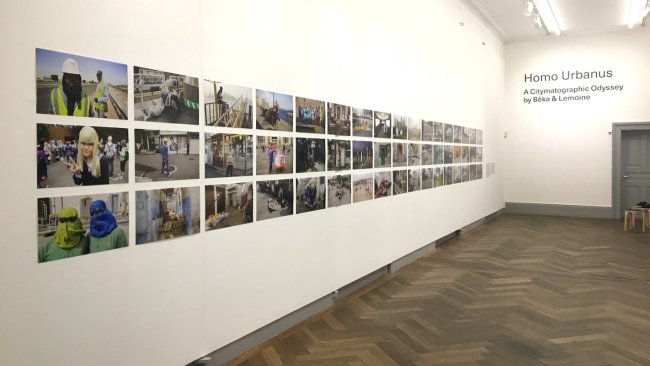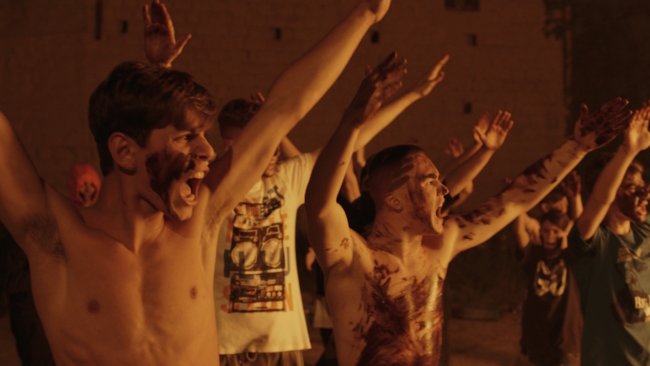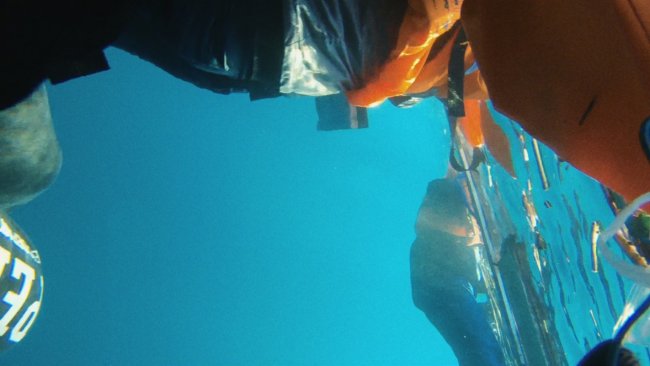Revolting Rhymes
[…] Wolf sets upon the babysitter and Red’s two children and puts the record straight. They do not «know» these stories «made to sound all soft and sappy», he will tell them the «real ones» which are true and «much more gory».
[…] The use of elemental geometries composed in oddly juxtaposed scales and depths permit different sensations of each frame’s overall materiality: sometimes cold, abstract, or faintly impressionistic, other times soft or richly luscious in definition and detail.
[…] Their film is original and pronounces more emphatically the radicalisation of the feminine in Dahl’s characterisation of Red Riding Hood.
[…] The anti-capitalist theme is brought out with more contemporary relevance. But the great stash of gold and money that always requires redistribution from the rich to the poor in these tales takes on a questionable libertarian flavour.
Text: Jodie McNeilly

If you know how long it takes to make a 3D animation using computer generated images, then you can be nothing but overly impressed by the speed and organisation that directors Jakob Schuh and Jan Lachauer with their design and production teams (split between Berlin and Cape Town) took to create one hour of animation. Even though they did not generate the characters or poetry from scratch, the final BBC commissioned work Revolting Rhymes (2016) was produced in just 16 months to celebrate “Roald Dahl’s Centenary”. Their efforts amount to a cleverly constructed, and dramaturgically strong narrative that weaves five classic fairy tales from Dahl and Illustrator Quentin Blake’s 1982 publication into an exciting new journey.
The tales of Little Red Riding Hood, Snow White and Three little Pigs are twisted together in the first part, while Jack and The Bean Stalk intersected with Cinderella comprises the second part of the overarching story that binds the five harmoniously. The Big Bad Wolf seeks out the now mature, city-residing single parent of two small children “Red” who dons a wolf skin coat and pig skin handbag after sleighing the wolf’s nephew who ate her Grandmother, and the Third Little Pig who is a greedy mortgage lender and steals all of Red’s money. Wolf sets upon the babysitter and Red’s two children and puts the record straight. They do not «know» these stories «made to sound all soft and sappy», he will tell them the «real ones» which are true and «much more gory».
The two worlds and timelines are animated differently. The world of “Wolf the Narrator” has a verisimilitude corresponding to our reality. The setting – a café and Victorian terrace – are represented in the finest of details (texture and print of fabrics, steam from a boiling copper pot, the naturalistic glint of street and lamp light reflections) with a motility that demarcates the fairy tale “past” from the irruption of the fairy tale “present”. The figures of Wolf’s narration move naturalistically in a realist rendered space. Their dialogue is pedestrian and bereft of Dahl’s rhyming couplet which only comes to life during Wolf’s storytelling.
Seamlessly we shift from one world to the next in both story and visual language. The landscapes of the fairy tales are fantastical, flattened and do not move. There is a gothic-absurdist feel to the scenography of Part One with hand moulded objects and shapes leaning oblique with jagged arrest against static backgrounds. The use of elemental geometries composed in oddly juxtaposed scales and depths permit different sensations of each frame’s overall materiality: sometimes cold, abstract, or faintly impressionistic, other times soft or richly luscious in definition and detail. The lighting (Thomas Ziegler) of each scene brings a sculptural depth to the characters’ minimalist bodies and features that echo Blake’s whimsical illustrations. While their limbs are elongated tubes moving only at the joints with faces round in shape supporting very simple features, the depth of their expressions are aided by a strong cinematic attention to the combination of shots (long, mid, wide, close and overhead) and how each scene is lit. One scene in particular involves a downward tilt that locks in at distance a tiny “Red” selling flowers beside the butchery where the huntsman will later buy a surrogate heart to trick Snow White’s step-mother the Wicked Queen. There is a beautiful play of exaggerated scale between Red’s tiny figure (centred in frame) and the gigantic, dimpled cement rendered wall as surface for the shadows of buildings and movement in the streets projected by the fading daylight. We get a sense of time passing and the atmosphere of place. A very satisfying moment in a film offering other such moments.
Schuh and Lachauer manage to sustain an integrity toward Dahl’s verse in their recompositing of the five tales. They also pay great homage to Blake’s visual language, retaining its essence while not plagiarising his line work. Their film is original and pronounces more emphatically the radicalisation of the feminine in Dahl’s characterisation of Red Riding Hood – no longer a sweet would-be victim, but a cold-hearted slayer who is self-determining and ready to take what is hers. But we find a tenderness in the animation not available in Dahl through the quasi-lesbian relation that develops between Red and Snow White.
The anti-capitalist theme is brought out with more contemporary relevance. But the great stash of gold and money that always requires redistribution from the rich to the poor in these tales takes on a questionable libertarian flavour. The fortune is meant for the “decent” hard working individual to amass for themselves (Jack and Cinderella), not necessarily to share amongst the under privileged. Or it is meant for the seven ex-jockeys whose “heigh ho” is no longer for hunting but for excessive gambling at the horse track. With the help of the stolen magic mirror each soon show with their millions «that gambling’s not a sin» if you win. Dahl’s anti-royalist, republican spirit is further co-opted to animate the kings, queens and princes as greedy, fickle and pathetic (Snow White and Cinderella). While Red’s Baader-Meinhof show down with the third little “banker” piggy becomes an appropriate trope for violent resistance against the fattening 1% identified since the Arab Spring riots and Occupation protests.
Overall Dahl’s rhymes are more pessimistic about the human condition than the animator’s re-envisioning of these tales. There is no “just” motivation for vengeance with his Little Red Riding Hood. Red is mean, just like Goldilocks who is nothing but «a brazen little crook» - and interestingly, the only tale left out in the animated reprise. In Dahl’s version, the wolf would not have left the children sleeping, finding a peaceful closure with their cute innocence. Rather he would have served them as soup to their mother. The film expresses some hope with children to overcome the ills of the world. Dahl makes us understand that children are just as wicked and weak (if not more) than the adults and predators whom they encounter.
There is no denying that the animation successfully participates in the much celebrated legacy of Dahl’s and Blake’s original rhymes and illustrations, and could very well become a children’s classic in its own right.
This article contains a third-party video. If you would like to watch the video, please adjust your settings.
Info
Revolting Rhymes – Part 1 and 2 | Film | Jakob Schuh, Jan Lachauer | UK-DE 2018 | 61’ | Festival Fantoche Baden 2018
First published: September 11, 2018



